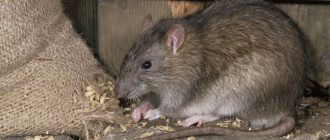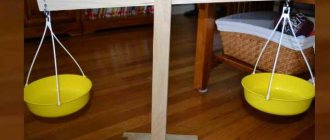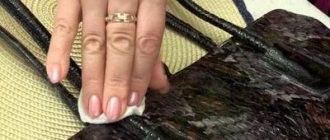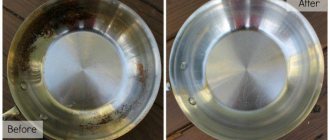Practice shows that self-made rat traps are more effective. After all, the rats are moving from another shelter, where purchased traps and traps could be used. The animals will already avoid them.
Before you get started, you need to watch a video of making the rat trap you are interested in, so as not to miss the details, and also take into account important aspects:
Rats are very smart and easy to train. And rat families are large. If one or two rats fall into the trap, it becomes temporarily useless: experience will prevent other individuals from getting there. Therefore, it is better to have several options.
Rats are strong animals and easily get out of the bucket. Therefore, it is necessary to pour water into the buckets used for traps or take high containers.
As bait, it is better to use lard, smoked meats, sausages - products with a strong odor. Although bread would also be good.
How to make a rat trap from a plastic bottle?
The simplest one: take a bottle and string it lengthwise onto the rod. Next, we place the rod on the edges of the bucket.
Lubricate the bottle completely with sour cream, stew or porridge. We build a bridge from a plank to the bottle.
The rat climbs onto the bottle along the bridge, the bottle spins and the rat falls into the bucket.
Cut the top of the bottle and open it slightly. We take the rod and attach a flagellum to it, which acts as a spring. We fix the rod itself in the notched part.
At the bottom of the plastic bottle, we attach a hook tied to the neck through a hole in the wall and string the bait. The animal pulls the bait, the top is pressed out and slammed shut.
The bottle with bait inside is placed on the edge of the table. The bottom should extend almost half way beyond the edge. We fasten the neck with a rope of sufficient length into a nail driven into the table or in a similar way.
The rat is able to climb inside through the narrow neck, and the bottle hangs under its weight.
Iron bucket
This device effectively catches both mice and rats. For the work you need available materials. Creating a homemade product with a step-by-step description:
- Pour table salt into a container with warm water. It is stirred until it dissolves.
- Wood shavings or sawdust 1-2 cm thick are added to the liquid. The husk will cover the entire water surface, and the saline solution will prevent it from sinking.
- Bread crumbs or other products are placed on the camouflage coating.
- The bucket is placed on a chair close to the kitchen furniture. The edge of the container is placed at the same level as the table.
A rodent, tempted by an easily accessible treat, will quickly run into the sawdust and drown.
How to make the simplest rat trap with your own hands
Take the pan and turn it over. We lift the edge of the pan and rest it on a strip of cardboard placed edgewise. The bait is attached to the edge of the cardboard. The rat pulls on it, the strip tips over, and the pan covers the animal.
Similarly, instead of cardboard, you can use a coin. The bait is placed inside the container. When the animal crawls inside, it will knock over the coin and cover itself with a saucepan.
IMPORTANT: the pan must be heavy so that the rat cannot lift it.
Whatman paper with cuts is placed on top of the bucket. The bait is placed on it. Under the weight of its body, the rat will fall through the slits into the bucket.
- Bark beetles in a wooden house - a description of how to get rid of the borer beetle. Tips on how to permanently remove dangerous parasites (105 photos)
- How to get rid of bedbugs - tips on how to remove dangerous parasites from a house or apartment (115 photos and videos)
Cockroach trap: review of the simplest and most effective methods of catching cockroaches (125 photos)
Electrical device
Without special skills and knowledge in the field of electrical engineering, it is difficult to make such a homemade product. Materials for the electric trap:
- plug;
- socket;
- 2 capacitors;
- resistor R2;
- diodes;
- 2 getinax s1 plates;
- resistor R1;
- the wire.
Strictly adhere to the electrical trap assembly diagram, otherwise there is a risk of a short circuit (such current is not dangerous for humans).
To make the device, buy a pair of getinkas plates, 1 mm thick, with foil on one side. You can get by with a budget option and build a device from metal strips. The structure is installed on a wooden floor. The width of one strip is 1 cm, length - 50 cm. The gap between the elements is 1 cm. The procedure according to the diagram and drawing:
- Electric capacitors are used to secure the edges of the strips. A soldering iron and tin are used to solder the leads of the parts to the plates. As a result, a battery is formed.
- Take the wire connected to the outlet and attach it to two strips.
- An adapter is constructed from two plugs to provide the capacitors with an electrical charge.
- The current strength is reduced by installing a resistor with a resistance of 8 kOhm. It is placed in front of the diodes.
- One terminal of the 10 kOhm resistor must be fixed, but the other edge is left free. If you press a two-watt electric element with a wooden stick, it will charge in 5 seconds.
Before hunting rats, the device is charged with a rectifier up to 300 V. They look for the pest's hole and place the device in front of it at night. The bait is placed there. The next morning there will be a corpse in the trap.
Glue traps
This is what you need to be careful with. Adults, and especially males, are large and strong. They are able to get out, and, as a rule, they get out of the glue and crawl away. Rather, the glue is only effective against baby rats (when they become the size of a mouse, they also go hunting).
It is important to choose a stretchable adhesive and spread it very thickly onto the piece of plywood. Place bait in the center.
Sometimes it is recommended to spread glue on the cardboard. But in this case, the adult rat will pull it along with it when trying to get out and may get stuck with it somewhere. The smell from the rotting body of the animal will make itself felt.
Killing Loop
A convenient killing device for catching pests is made from bars and wire. These homemade rat traps are put together step by step:
- Prepare a wide beam 40 cm long.
- A hole with a diameter of 9 cm is made in the material.
- Stepping back from the edge of the workpiece by 6 cm, create a notch with a large depression.
- A powerful spring is attached to the top of the device with metal brackets.
- 4 cm are removed from the cut, 2 small symmetrical holes are made in the upper part.
- 2 more holes are drilled at the bottom of the wood, a strong thread is inserted into them, passed through the upper holes and tied to a spring.
- A loop is made from thin steel wire. It is installed in the file and tied to the edge of the spring.
- The structure is installed opposite the hole and equipped with food. The principle of the noose trap is to suffocate the rodent
The principle of operation is simple: the animal will head towards the bait, and the stretched threads will block its path. The rat will gnaw through the obstacle, at that second the spring will be released, rise sharply upward along with the loop and strangle the pest.
How to make a tunnel type trap
We take whatman paper or cardboard, roll it into a tunnel and attach it to the table with tape. You can take a piece of pipe. Half of the tunnel should hang over the edge.
At the end we put bait, again preferably with a strong aroma, although bread will do. Place a bucket of water or a tall container (barrel) down.
This trap is difficult to make, but effective. The entrance hole of the tunnel trap is made in the form of a valve with sharp needles directed inward. The rat will climb for the bait, but there will be no return because of the needles.
- Remedies for bedbugs: modern methods and tips on how to effectively remove bedbugs (110 photos + video)
How to make a mousetrap: rating of the best models and tips on how to catch a mouse with your own hands (115 photos and videos)
- How to get ants out of the house - reasons, methods and recommendations on how to get rid of them once and for all (100 photos)
Option number 6: snare
Generally speaking, catching rats with snares is quite problematic due to the small size of the animals. However, if you try, you can still catch the pest, and there is even a small life hack that allows you to make such a rat trap with your own hands from improvised means.
For this you need:
- Cable tie;
- A piece of fishing line;
- Heavy load - for example, a wrench;
- Paper clip;
- Bait - for example, a crust of bread.
This is how a homemade rat trap made from a cable tie works in practice:
On a note
When making this trap, it is important to choose the right weight of the load. If it is too small, it will not tighten the tie with the necessary force, and the rat will run away. If the load is too heavy, then using such a structure as a live trap will not work - the animal’s ribs will be broken by the loop.
Cage trap
For manufacturing you will need a strong steel mesh, wood and metal panels, and a spring for the trigger mechanism.
The trap door opens upward with spring tension. A guard with a hook at the end of the cage is attached to it. The bait is attached to the hook. The rat pulls the bait and the door slams shut.
And also a few words about commercially available lethal rat traps (traps)
All of the homemade rat traps described above have an important feature - they allow you to catch the animal alive (the so-called live traps).
However, you can also effectively fight rats using commercially produced traps that will kill rats. For example, among the most popular are the following:
- A standard trap-press (popularly often called a mousetrap) - it can have several modifications;
- Tunnel trap similar to Clean Kill Mouse Trap from Victor;
- Electric rat trap (battery-powered, and there are models that automatically place a killed rat in a special compartment, allowing you to destroy several rodents at once).
In conclusion, it is worth noting that the effectiveness of a particular trap, be it homemade or industrially produced, largely depends on the correct choice of bait. Read more about choosing baits in a separate article: The best baits for rats and mice.
Useful video: a clear example of how an electric rat trap works
Zürner trap
It works on the principle of tipping traps. This is a one-piece, durable design. It can catch several individuals at the same time.
It is made in the form of a wooden house with two entrances. The filling is placed in the center of the corridor. And the boards from it are attached to hinges. Under the weight of the rat, the board lowers and then returns to its original position.
- How to get rid of small midges - how to get rid of them once and for all at home (85 photos)
- How to get rid of fruit flies - where do they come from and tips on how to quickly and easily get rid of fruit flies at home (105 photos)
Flies in the apartment: effective methods and recommendations on how to get rid of flies (110 photos and videos)
General information
Rats live not only in private houses, but also in apartments. Some apartment buildings are equipped with a garbage chute, through which rodents enter the staircase landing, and then into a person’s home. Owners of private houses and people involved in household work are faced with rodents. A distinctive feature of a rat from other types of rodents is its mental abilities, thanks to which it can survive.
In some cases, rat traps are ineffective because most people do not know how to use them correctly. In addition, a rat that has once been caught in a rat trap and survived is a difficult target to catch. Thanks to the instinct of self-preservation, she learns and subsequently avoids dangerous situations. There are known cases when the rat trap remained “loaded”, but there was no bait on the hook. There are many types of simple and very effective mechanical traps that you can make yourself at home.
Danger to humans
Rats are one of the signs of unsanitary conditions. The presence of food debris, warm rooms and humidity - all these factors contribute to their favorable existence. Multi-storey buildings are no exception. Residents of the first floors suffer especially from rodents. In addition, animals can live near a food source. Rats are very hardy and can travel long distances. They can enter the apartment through balconies, entrance doors and ventilation openings.
The main threats that rodents pose to humans are divided into two types: material and physical. The first type of threat is that they spoil food, furniture, clothing, and so on. Rats damage equipment by chewing through power cords. They destroy buildings by gnawing holes in the walls. The physical threat is the diseases they transmit to humans through their bite and feces. They carry dangerous diseases: leptospirosis, rabies, typhoid, and so on.
Features of using traps
DIY mechanical rat traps are the most reliable. The most common is the mechanical type rat trap. When an animal comes into contact with it, it dies immediately or remains until detected by a person. In addition, various types of poisons are used to kill rats, but they are not justified, since when poisoned, the rat crawls into its hole, which is located in hard-to-reach places. The rodent dies and begins to decompose, releasing a corpse-like odor.
Before using a trap (rat trap), you need to know the following rule: a rodent will not approach those traps from which it smells a human smell. You need to wear rubber gloves when setting the trap. Another rule to be aware of is that the trap must be placed against the direction the rat is moving. Rodents move quietly and carefully near walls as they try to remain unnoticed. It is advisable to place the trap near a hole or rat feces. The rat trap is not placed in a visible place, since the likelihood of an animal getting into it is negligible.
Photo tips on how to make a rat trap
Read here How to make a mousetrap: rating of the best models and tips on how to catch a mouse with your own hands (115 photos and videos)
Did you like the article? Share
0
The best bait for a rat trap
The diet of rats is varied; traps can be loaded with the following baits:
- cheese;
- grain crops;
- bakery;
- cottage cheese;
- sausage;
- smoked meats;
- sour cream;
- nuts;
- sunflower oil and seeds;
- salo;
- even beer, etc.
Animals love fresh and smoked food most of all; rodents should not be underestimated, they are quite selective.
What to do with a rat trap and a caught rat
Of course, a person is no longer a medieval barbarian, but in relation to a caught rat, there is only one solution - liquidation. This can be done as follows:
- add water to the container so that the animal drowns;
- a precise blow to the head with something like a bat;
- shoot the pest if you have a suitable weapon;
- if it is possible to transfer the animal into a sealed container, you can send the “criminal” to the gas chamber. Mix soda and vinegar in a cup, pour into a container, the animal will suffocate (this is considered a humane method of punishment).
The methods described seem terrible, but a person cannot, like the Pied Piper of Hamelin, control animals with a pipe, so there are simple methods of elimination.
Still, the best way would be to choose a trap that does not cause any injury to the animal and subsequently release it away from the area.
Precautionary measures.
When working with mechanical and electronic rat traps, you should adhere to the following rules:
- Do not install electronic devices in damp places.
- Do not place traps in areas where children or other animals are present.
- When removing caught animals from traps and rat traps, it is recommended to wear special clothing and gloves to avoid injury from them.
Sources
- https://vrediteli24.ru/gryzuny/lovushki-dlja-krys.html
- https://GdeKlop.ru/krysy/raznovidnosti-lovushek/
- https://severdv.ru/svoimi-rukami/lovushka-dlya-krys-svoimi-rukami/
- https://GdeKlop.ru/krysy/samodelnye-krysolovki/
- https://notklop.ru/krysy/sredstva-ot-krys/lovushki-dlya-krys/
[collapse]
The best commercial rat traps
The following commercial traps can be distinguished:
- Press traps.
- Tunnel traps.
- Electrical devices.
- Mesh traps.
- Ultrasonic repellers, etc.
For many, ultrasonic repellers have already become an excellent alternative to other control methods that involve killing animals.











